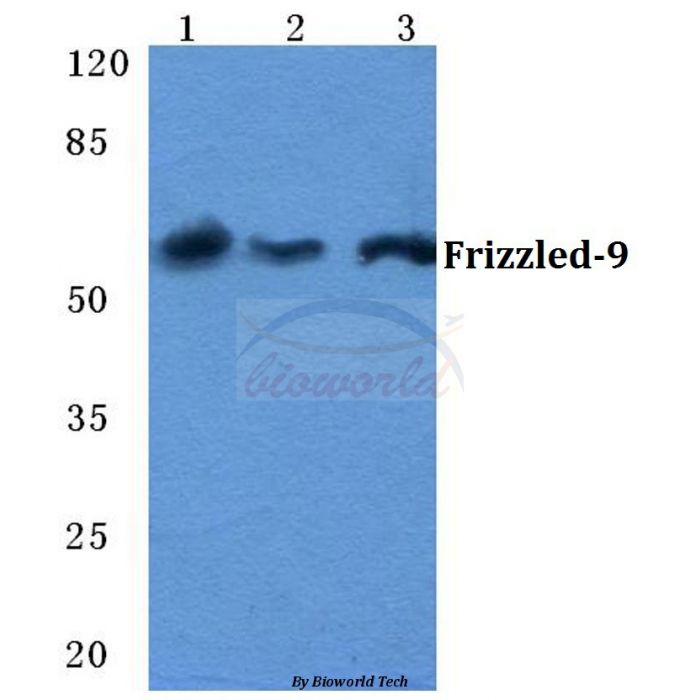CD349 (Frizzled)-9 polyclonal, anti-human, mouse, rat
€305.00
In stock
SKU
BS5723
Background:
The frizzled gene, originally identified in Drosophila melanogaster, is involved in the development of tissue polarity. The mammalian homolog of frizzled as well as several secreted mammalian frizzled-related proteins (FRPs) have been described. The frizzled proteins contain seven transmembrane domains, a cysteine-rich domain in the extracellular region and a carboxy terminal Ser/Thr-xxx-Val motif. They function as receptors for Wnt and are generally coupled to G proteins. The frizzled-9 gene is located within the Williams Syndrome common deleted region at chromosomal band 7q11.23. Heterozygous deletion of the frizzled-9 gene may contribute to the Williams Syndrome phenotype. In mouse, frizzled-9 overexpression can induce the hyperphosphorylation and relocalization of Dvl-1 from the cytoplasm to the cell membrane and cytosolic β-catenin accumulation. In rat, frizzled-9 is important in Wnt/β-catenin signaling in 293T cells. Frizzled-9 is expressed predominantly in brain, testis, eye, skeletal muscle, and kidney.
Alternative Name:
Frizzled9, Frizzled 9, Frizzled3, Frizzled 3, Frizzled-3,Fz-9, hFz9, FzE6, CD349, FZD9, FZD3
Application Dilution: WB: 1:500~1:1000
Specificity: Frizzled-9 polyclonal antibody detects endogenous levels of Frizzled-9 protein.
Immunogen:
Synthetic peptide, corresponding to amino acids 571-620 of Human Frizzled-9.
MW: ~ 64 kDa
Swis Prot.: O00144
Purification & Purity:
The antibody was affinity-purified from rabbit antiserum by affinity-chromatography using epitope-specific immunogen and the purity is > 95% (by SDS-PAGE).
Format:
1 mg/ml in Phosphate buffered saline (PBS) with 0.05% sodium azide, approx. pH 7.2.
Storage:
Store at 4°C short term. Aliquot and store at -20°C long term. Avoid freeze-thaw cycles.
For research use only, not for use in diagnostic procedure.
The frizzled gene, originally identified in Drosophila melanogaster, is involved in the development of tissue polarity. The mammalian homolog of frizzled as well as several secreted mammalian frizzled-related proteins (FRPs) have been described. The frizzled proteins contain seven transmembrane domains, a cysteine-rich domain in the extracellular region and a carboxy terminal Ser/Thr-xxx-Val motif. They function as receptors for Wnt and are generally coupled to G proteins. The frizzled-9 gene is located within the Williams Syndrome common deleted region at chromosomal band 7q11.23. Heterozygous deletion of the frizzled-9 gene may contribute to the Williams Syndrome phenotype. In mouse, frizzled-9 overexpression can induce the hyperphosphorylation and relocalization of Dvl-1 from the cytoplasm to the cell membrane and cytosolic β-catenin accumulation. In rat, frizzled-9 is important in Wnt/β-catenin signaling in 293T cells. Frizzled-9 is expressed predominantly in brain, testis, eye, skeletal muscle, and kidney.
Alternative Name:
Frizzled9, Frizzled 9, Frizzled3, Frizzled 3, Frizzled-3,Fz-9, hFz9, FzE6, CD349, FZD9, FZD3
Application Dilution: WB: 1:500~1:1000
Specificity: Frizzled-9 polyclonal antibody detects endogenous levels of Frizzled-9 protein.
Immunogen:
Synthetic peptide, corresponding to amino acids 571-620 of Human Frizzled-9.
MW: ~ 64 kDa
Swis Prot.: O00144
Purification & Purity:
The antibody was affinity-purified from rabbit antiserum by affinity-chromatography using epitope-specific immunogen and the purity is > 95% (by SDS-PAGE).
Format:
1 mg/ml in Phosphate buffered saline (PBS) with 0.05% sodium azide, approx. pH 7.2.
Storage:
Store at 4°C short term. Aliquot and store at -20°C long term. Avoid freeze-thaw cycles.
For research use only, not for use in diagnostic procedure.
| Is Featured? | No |
|---|
Write Your Own Review

